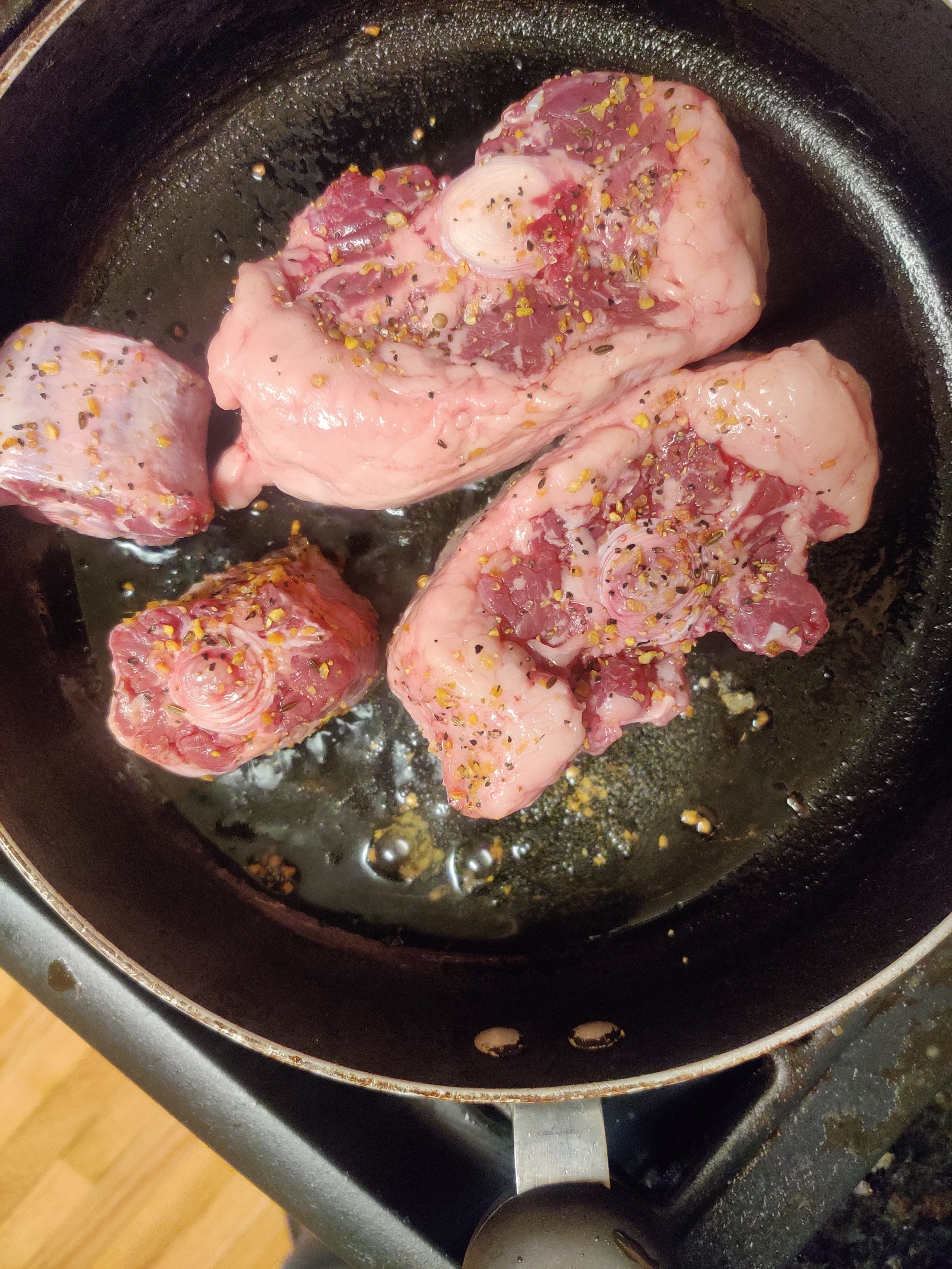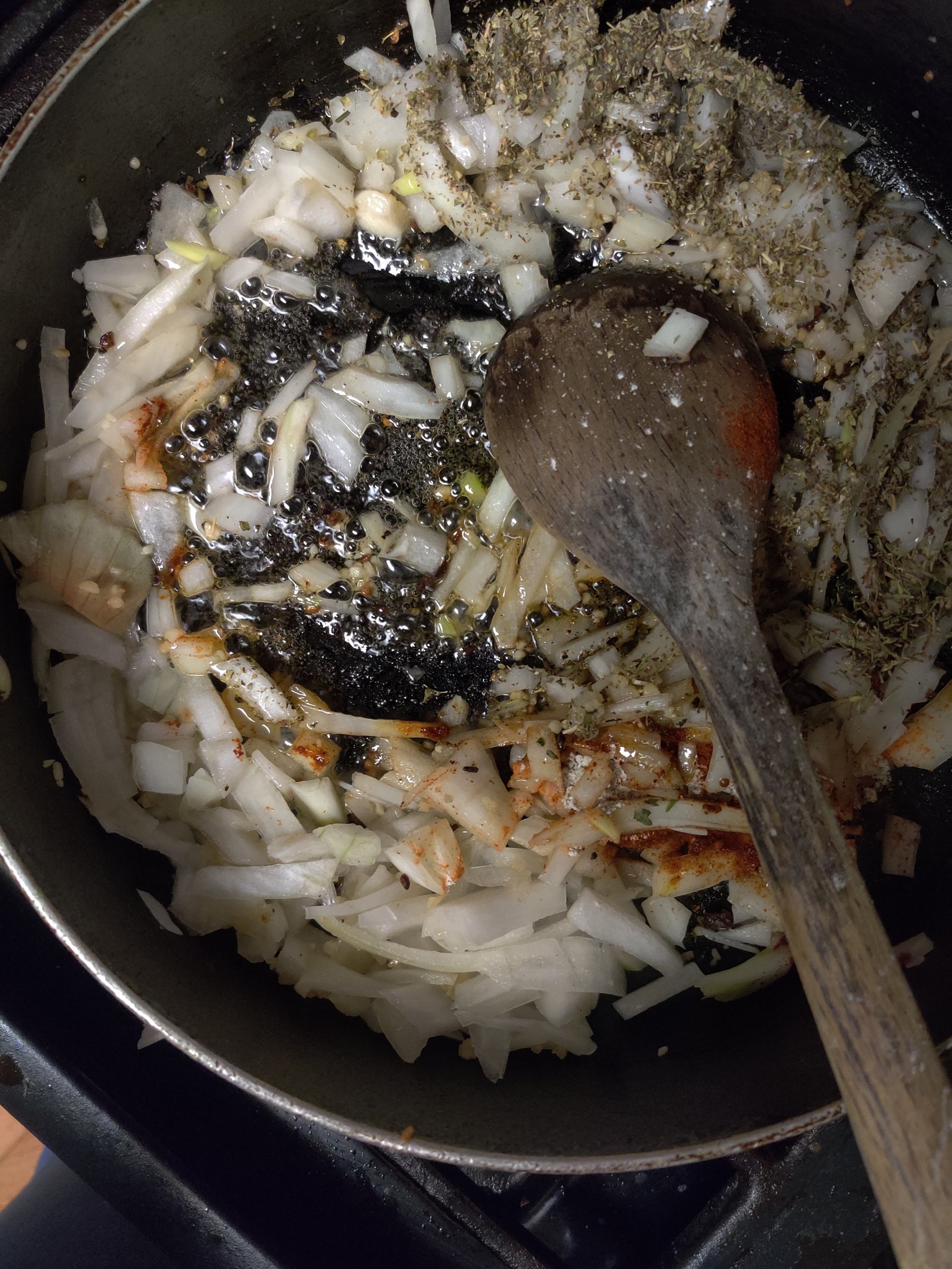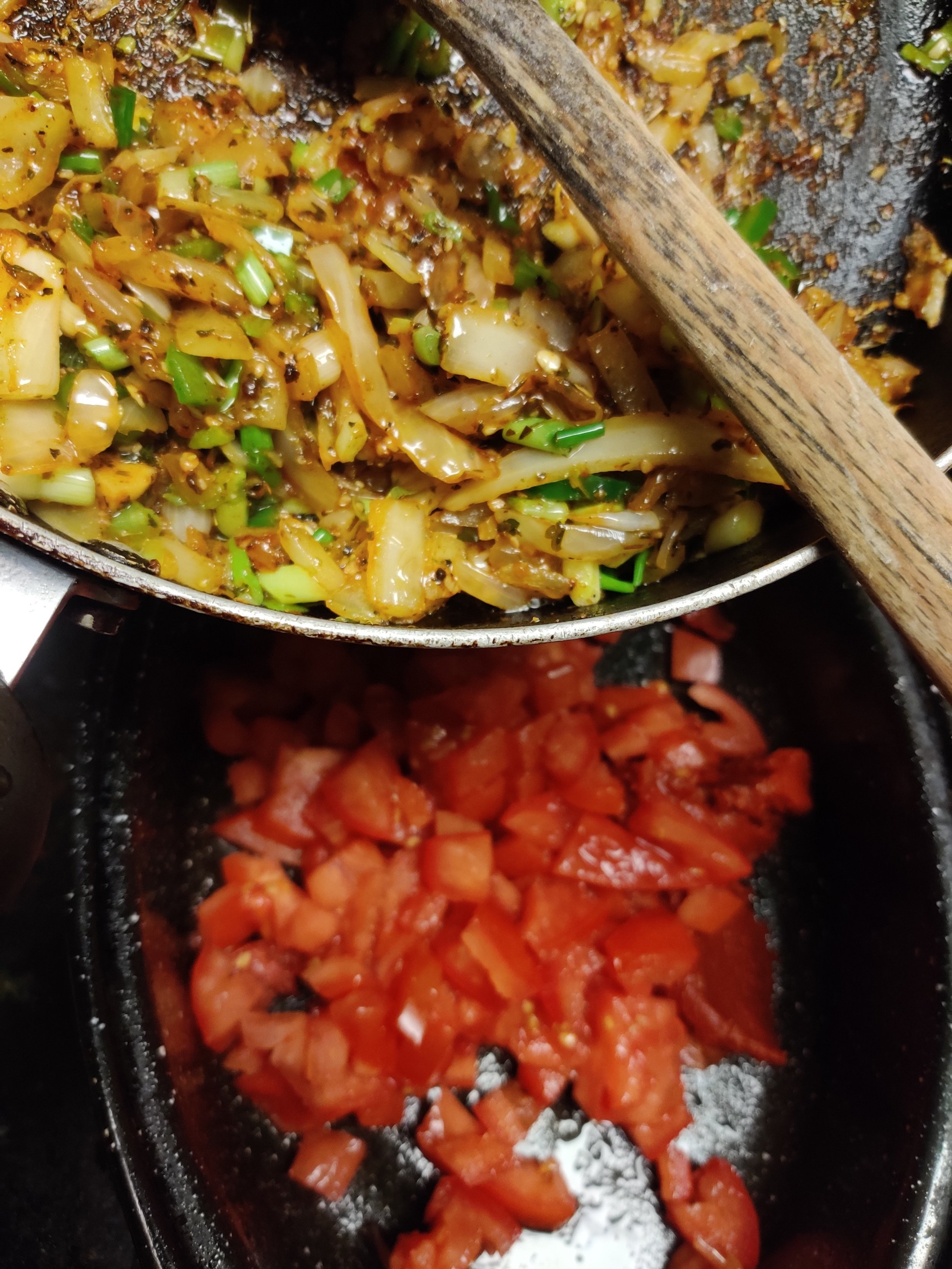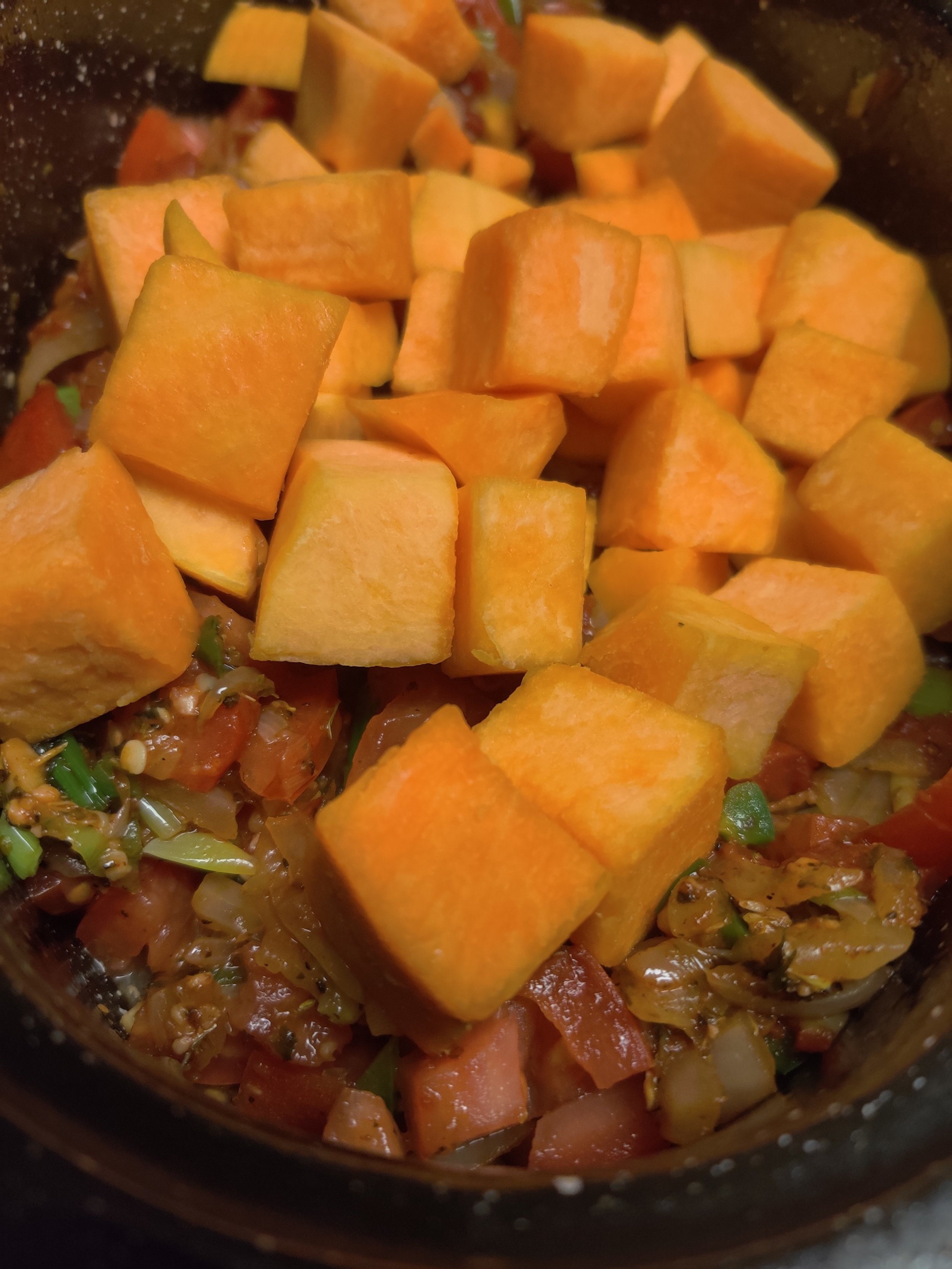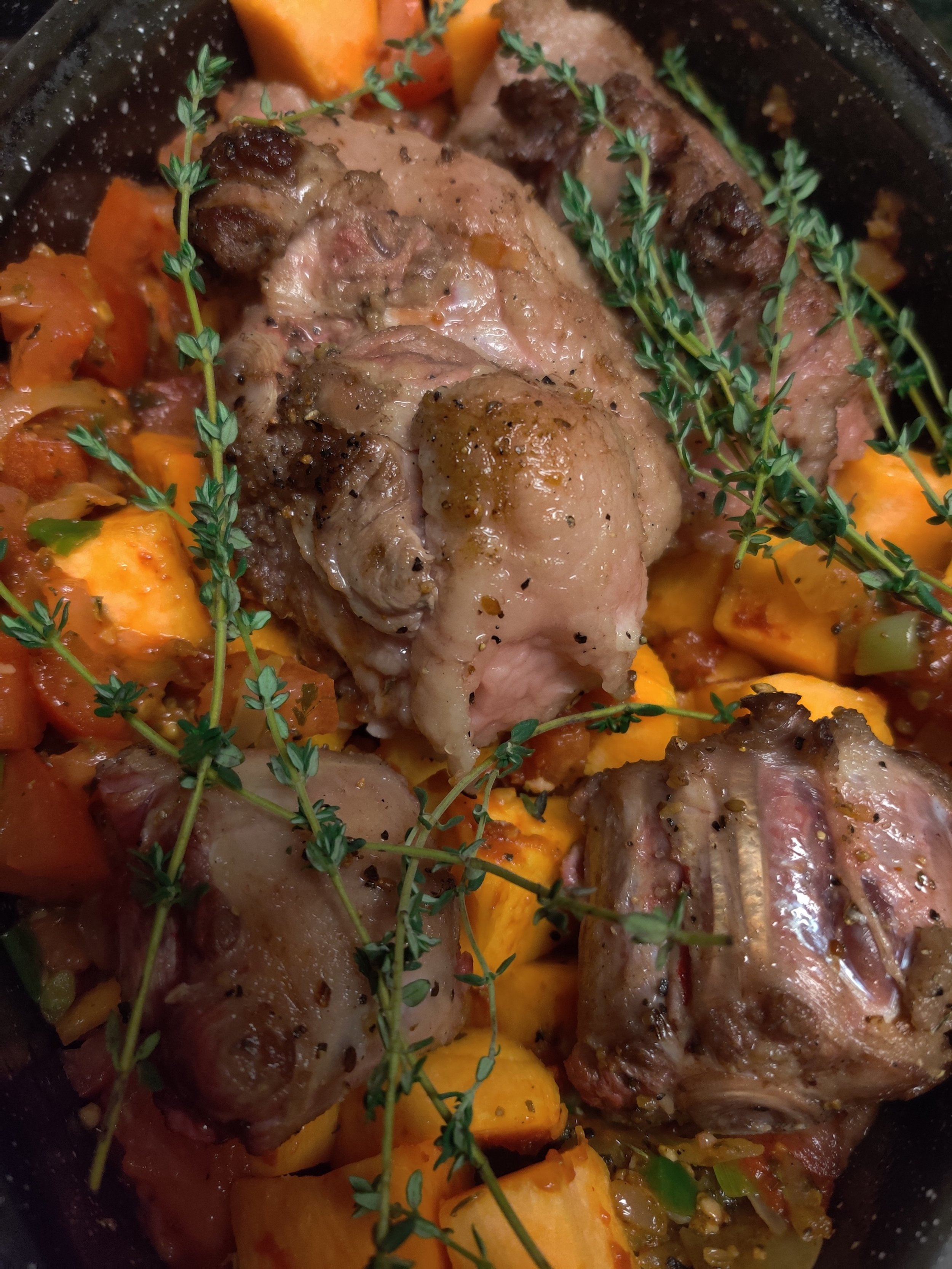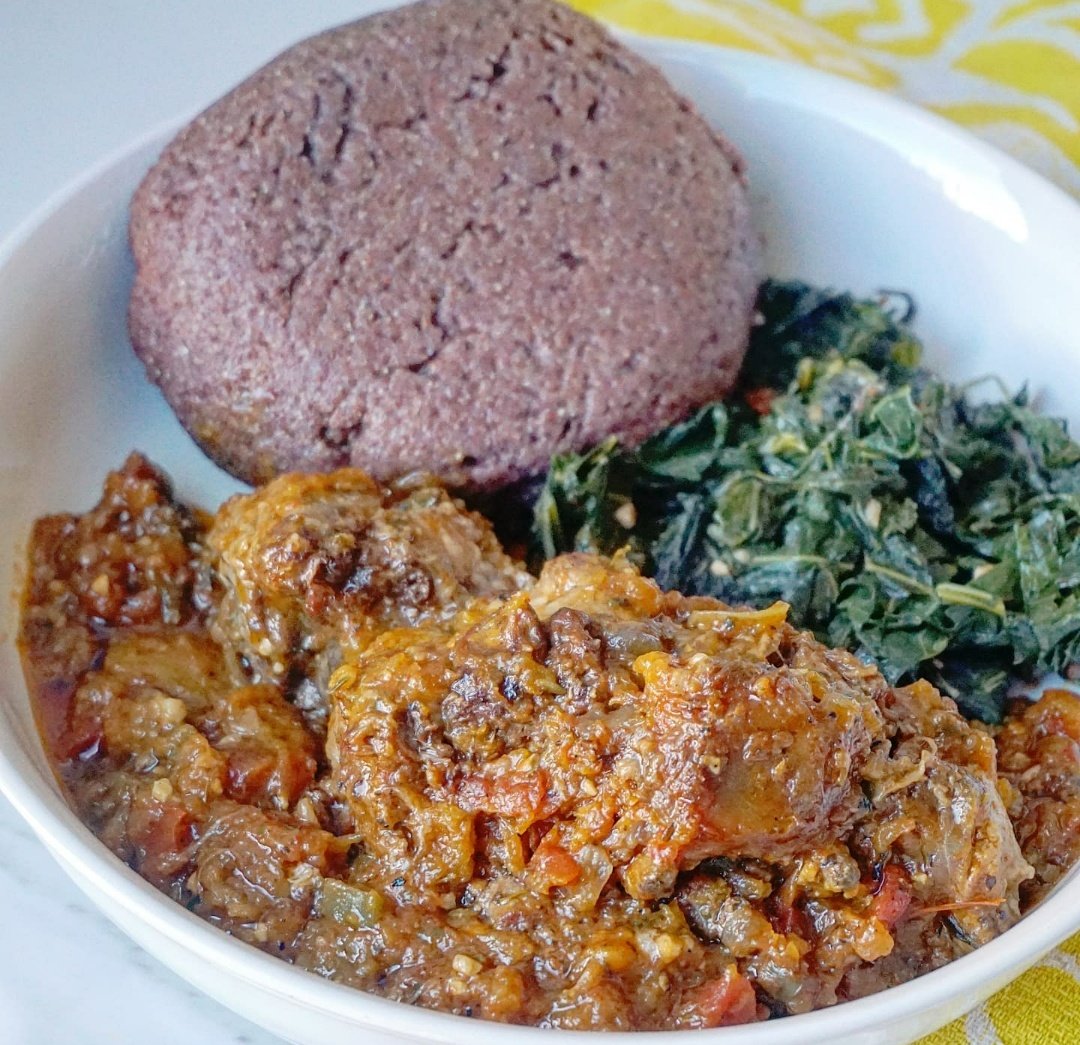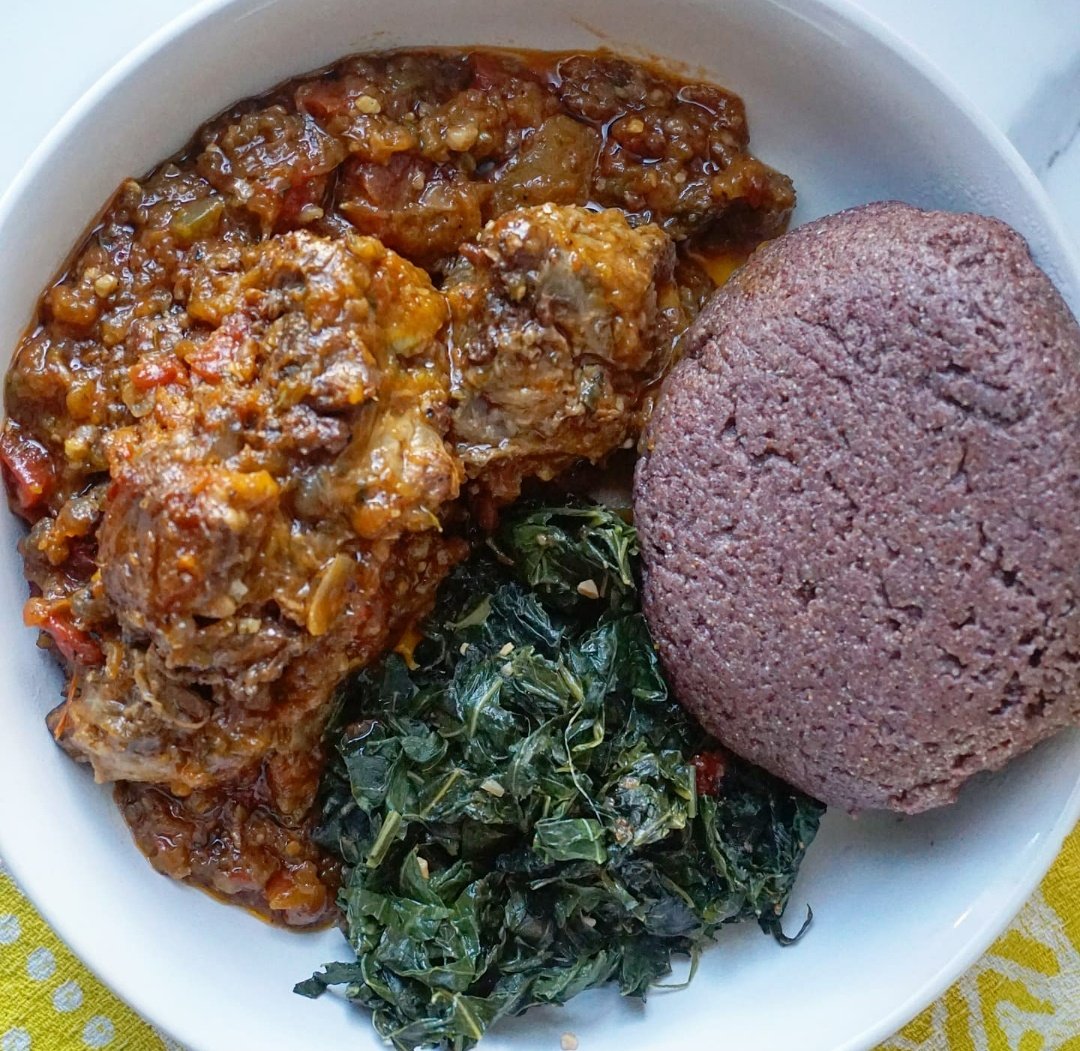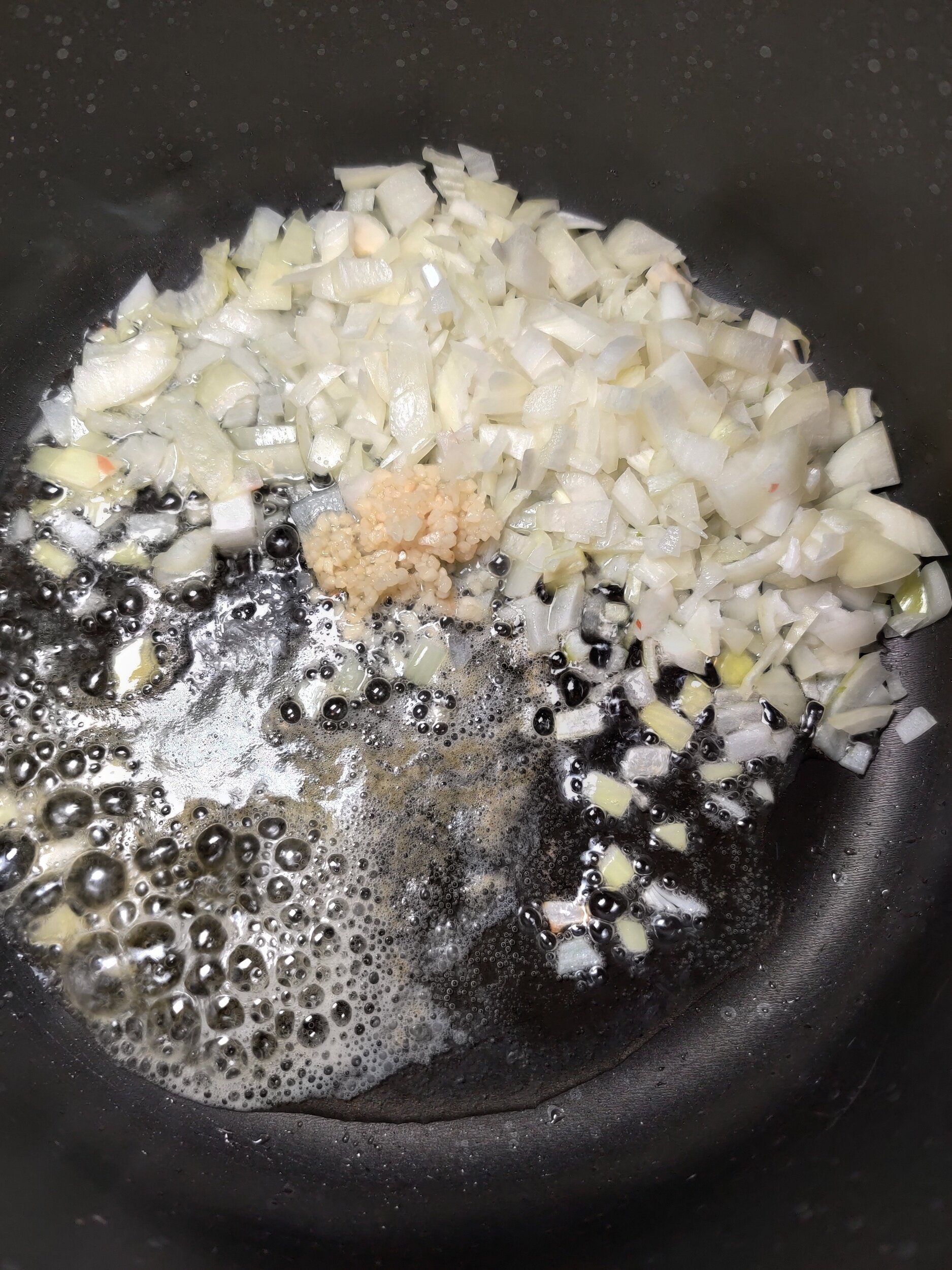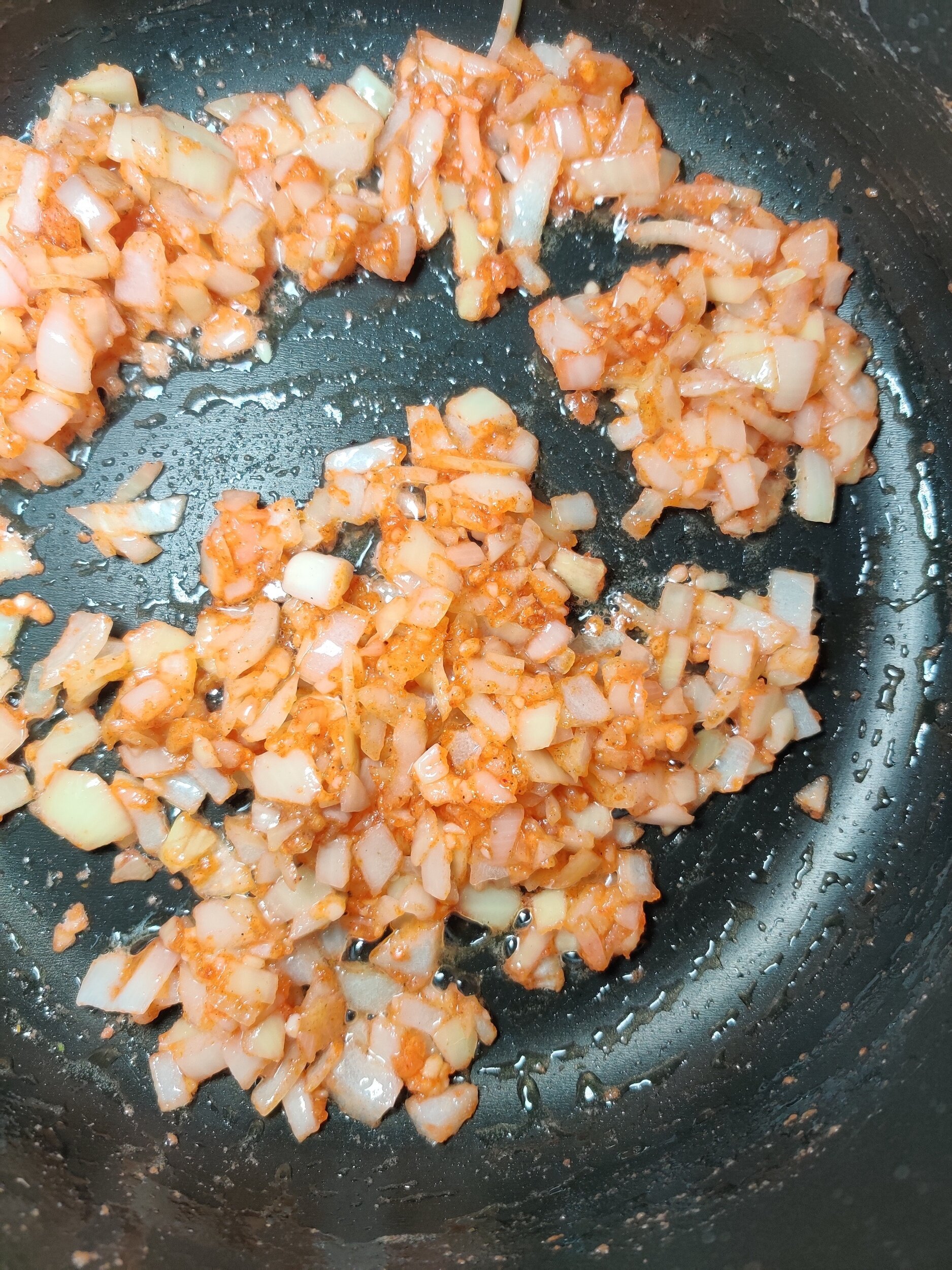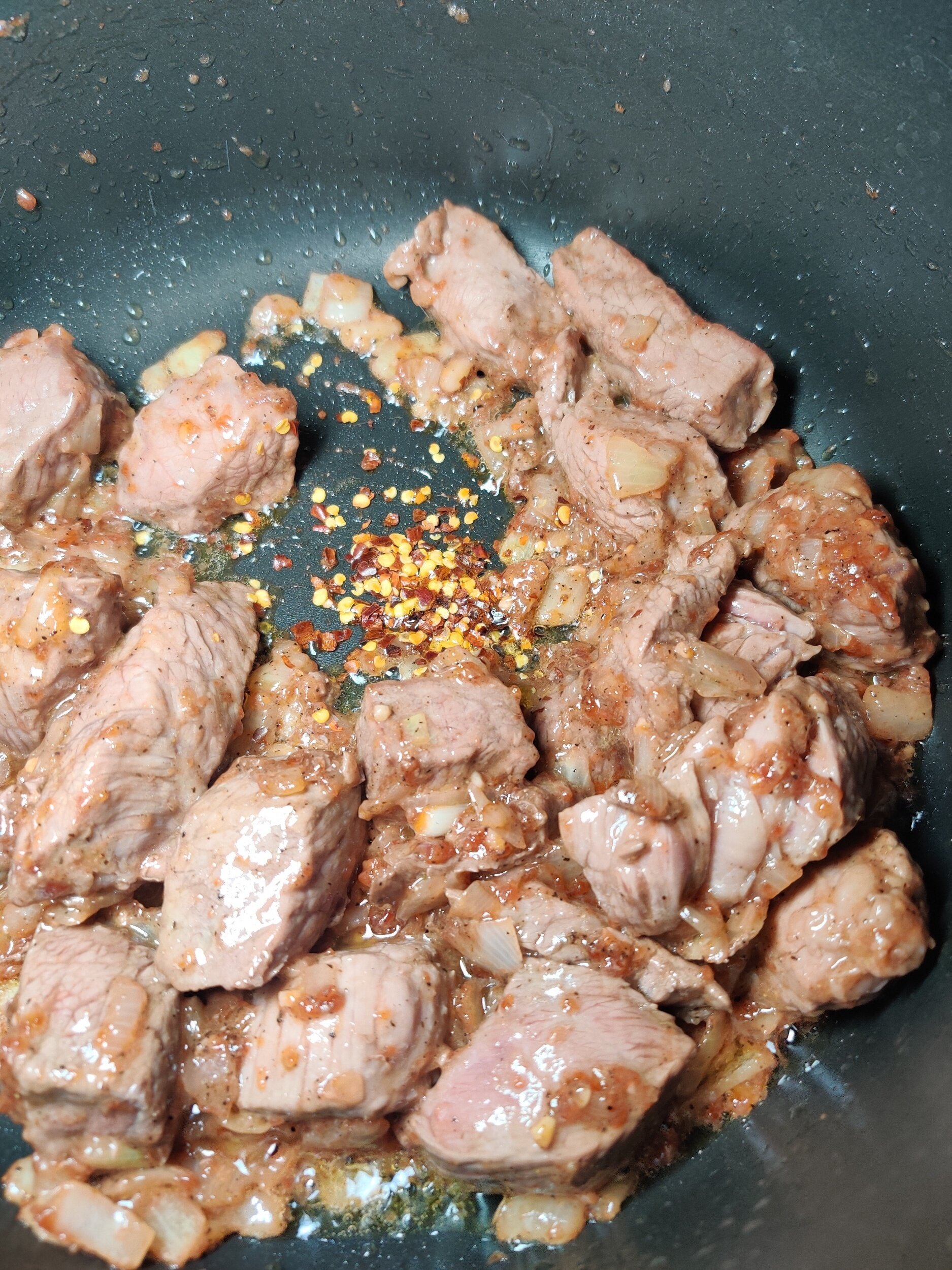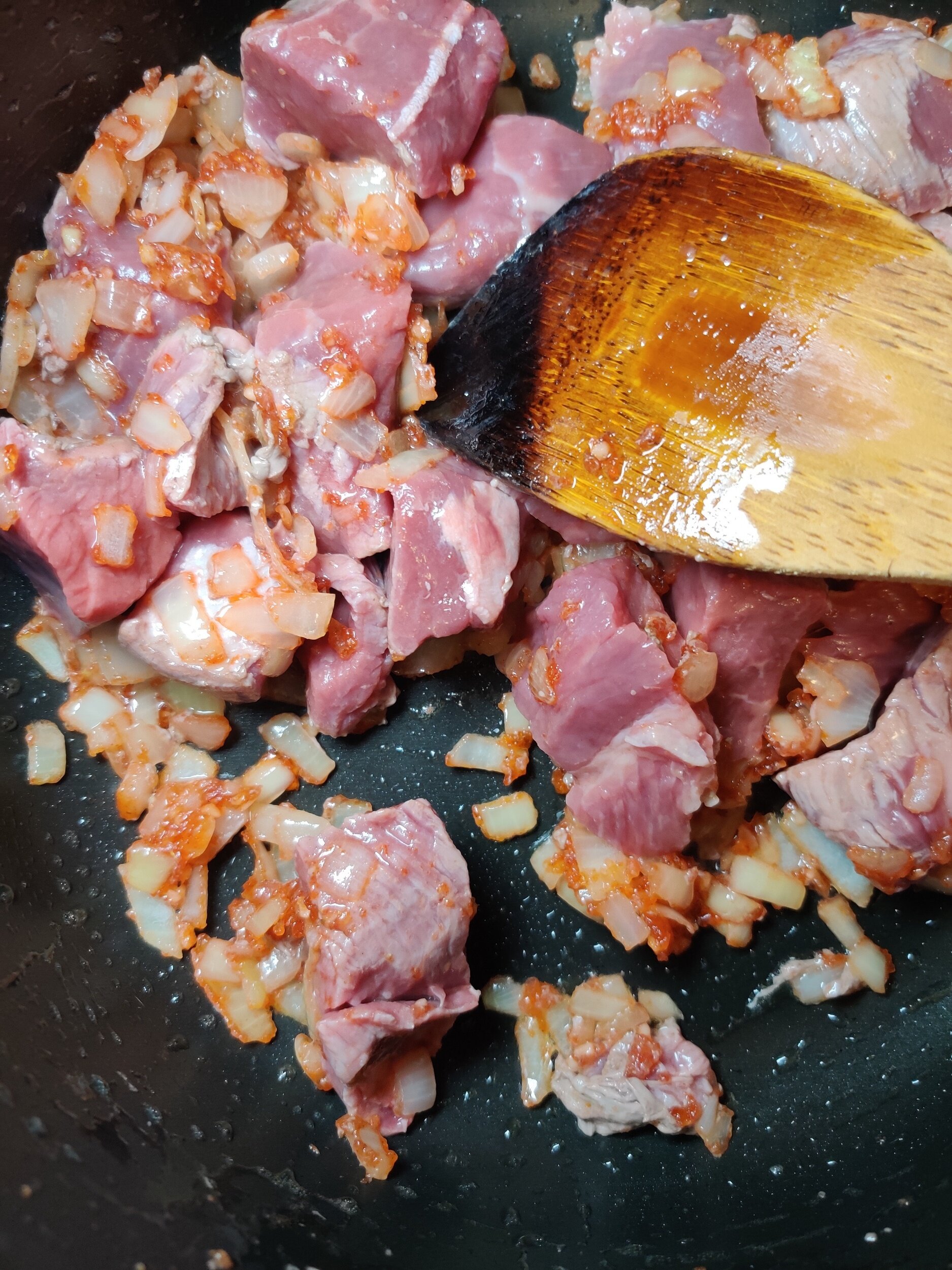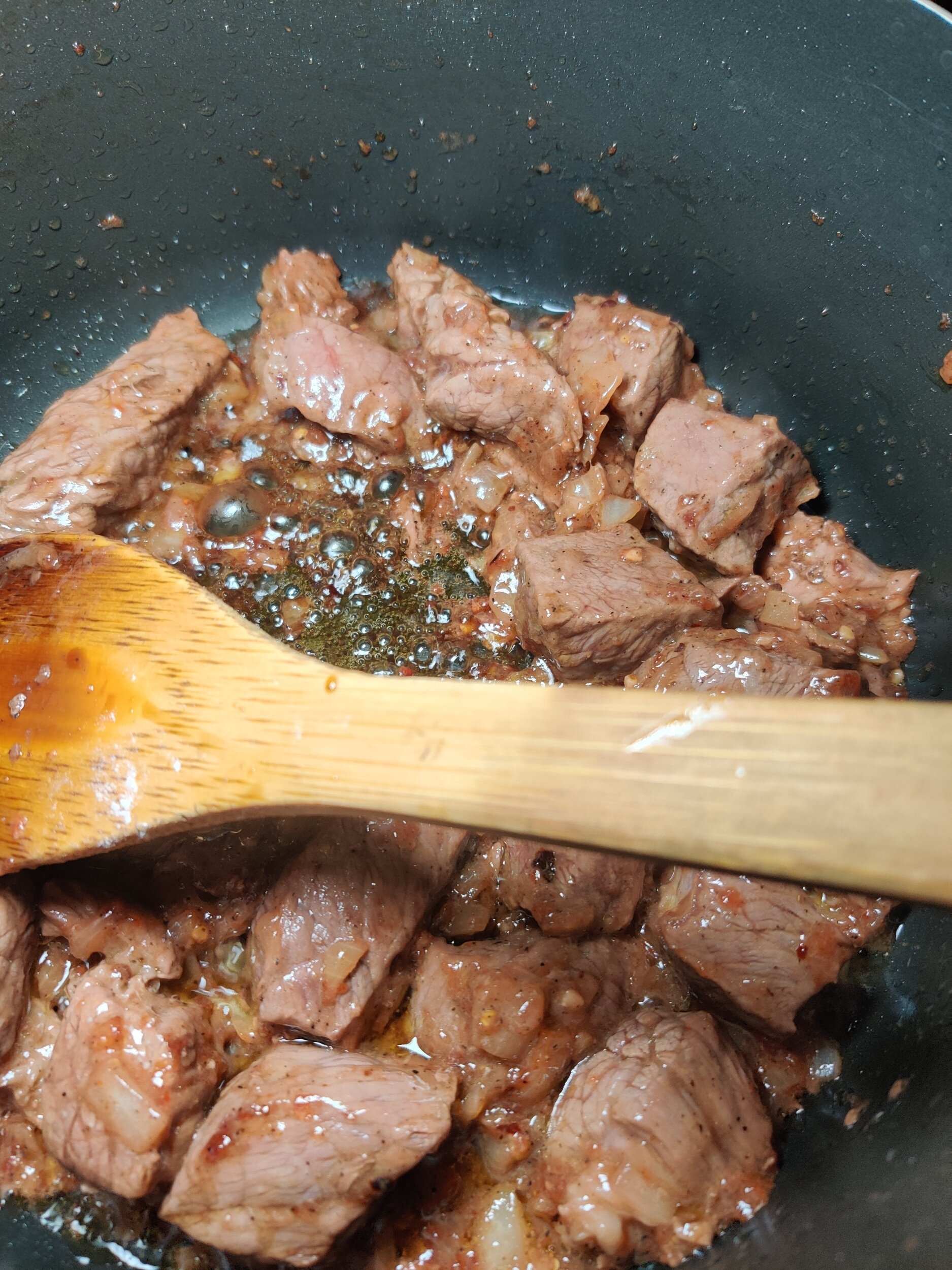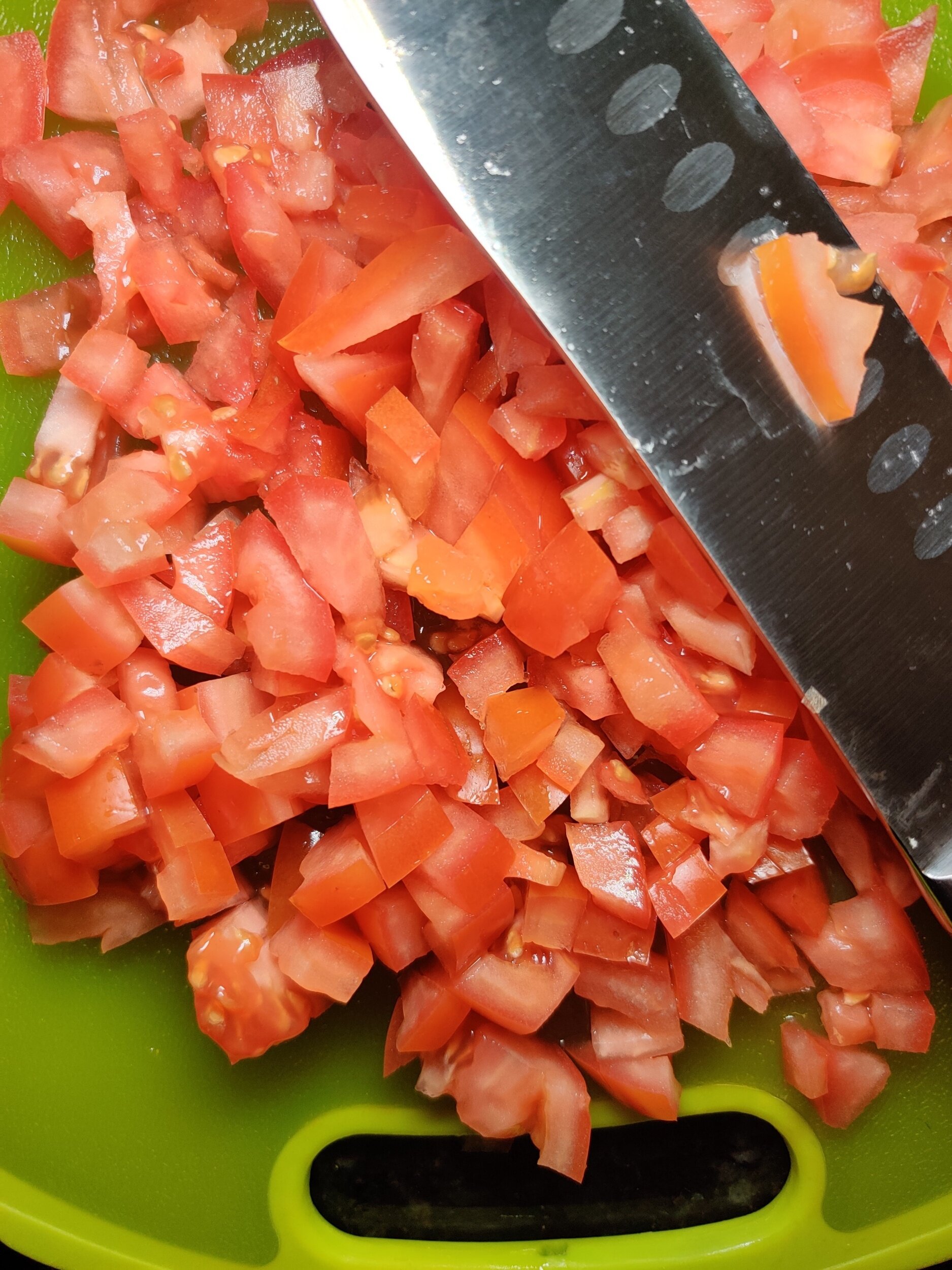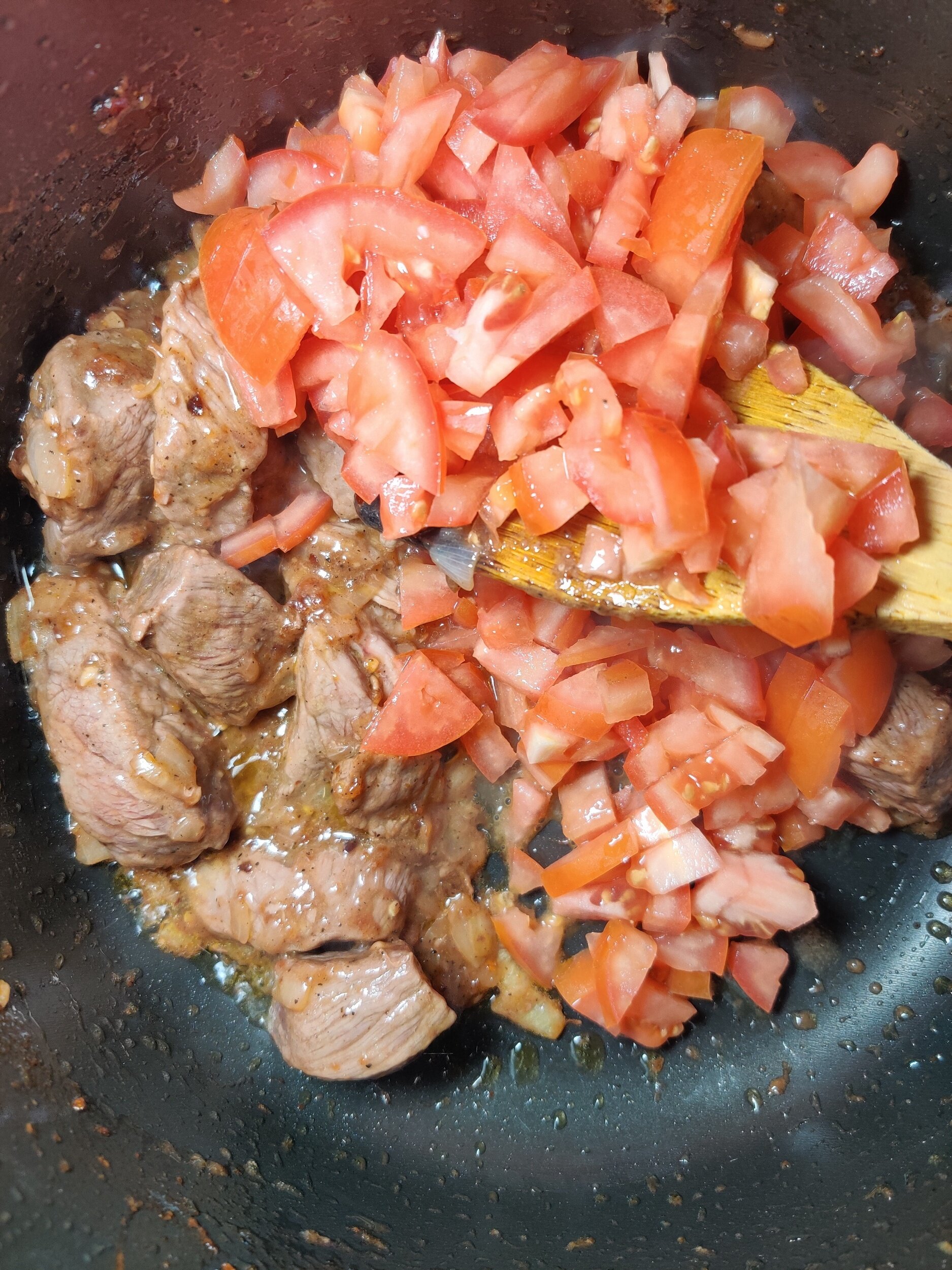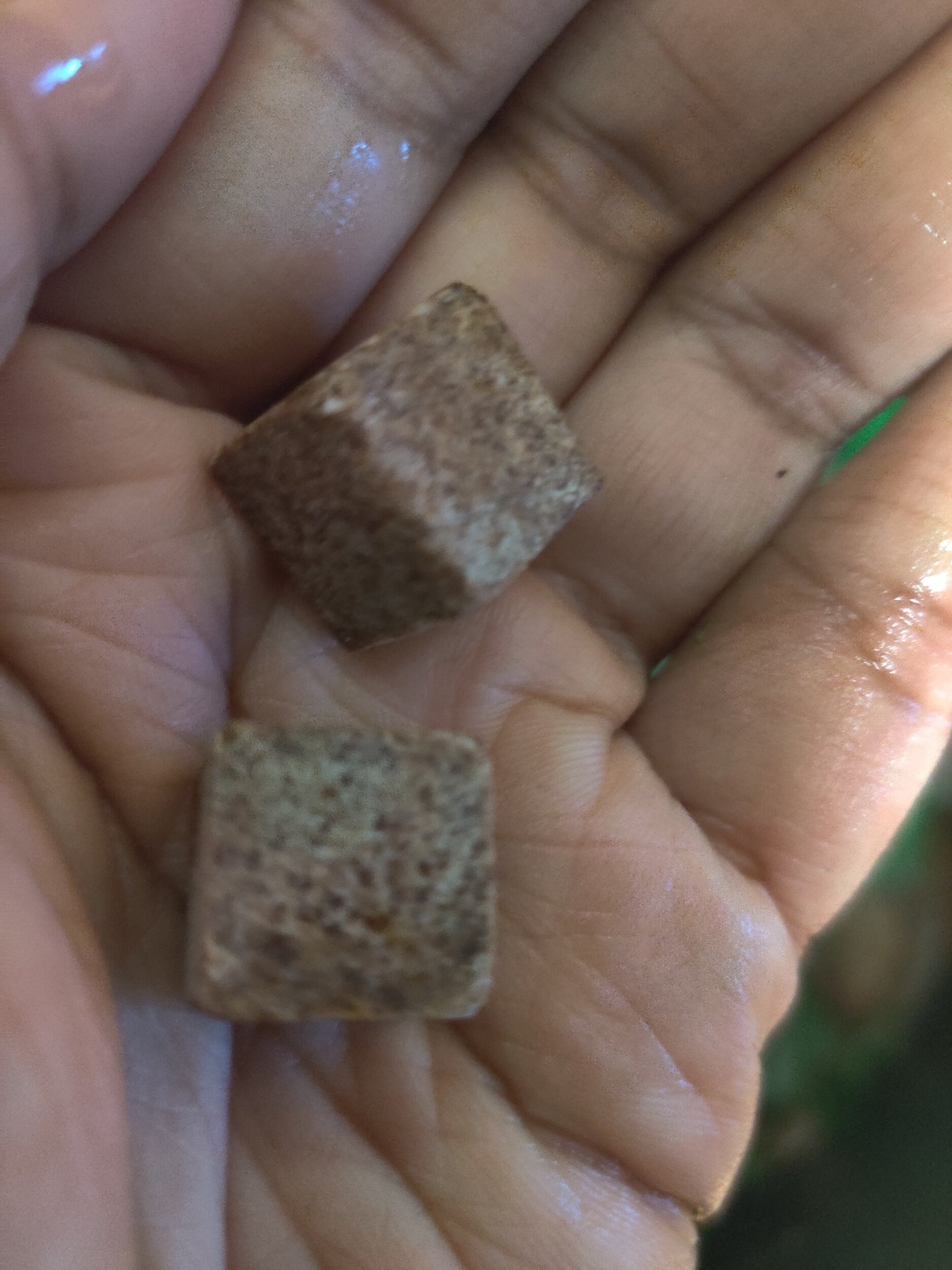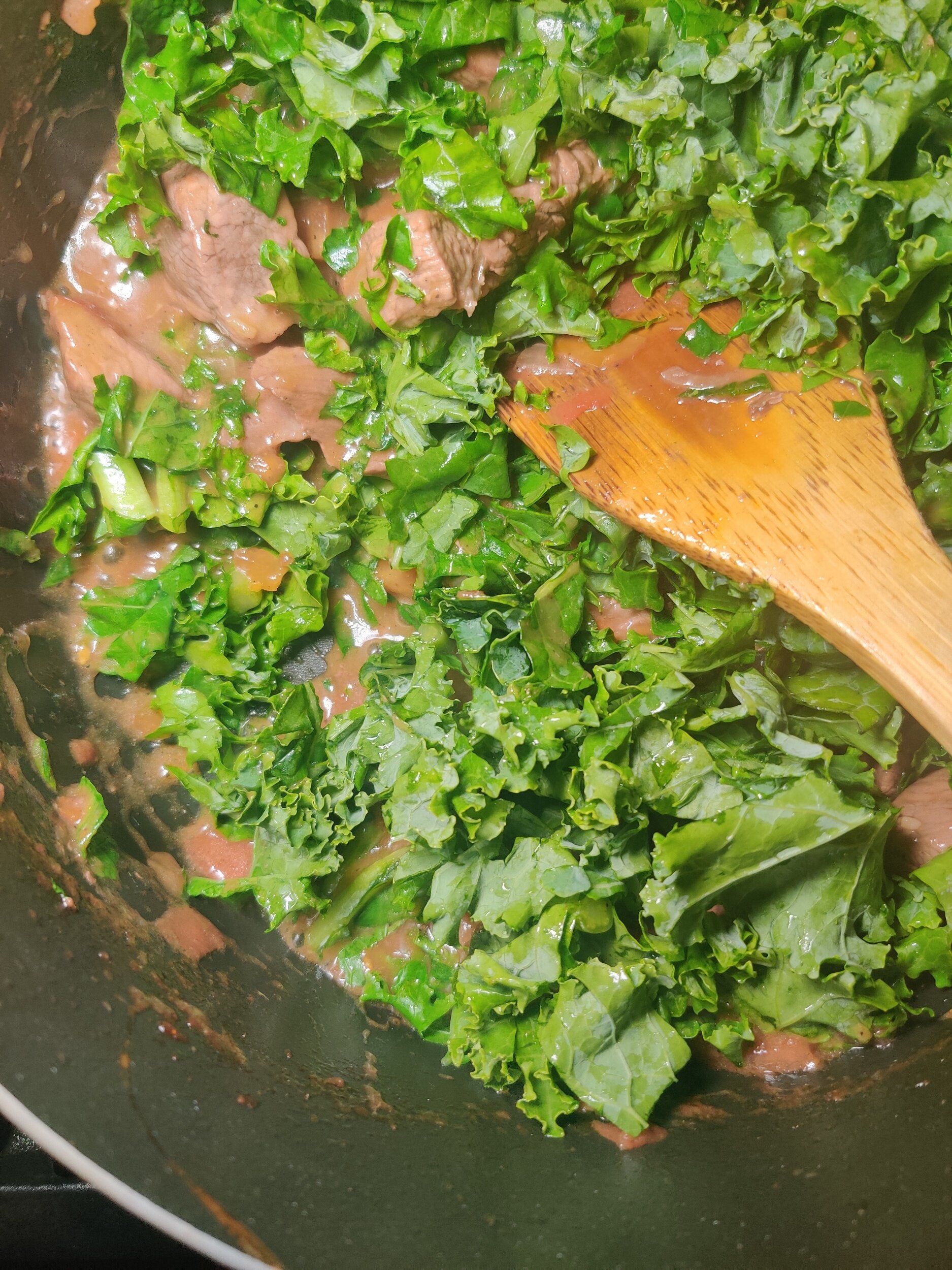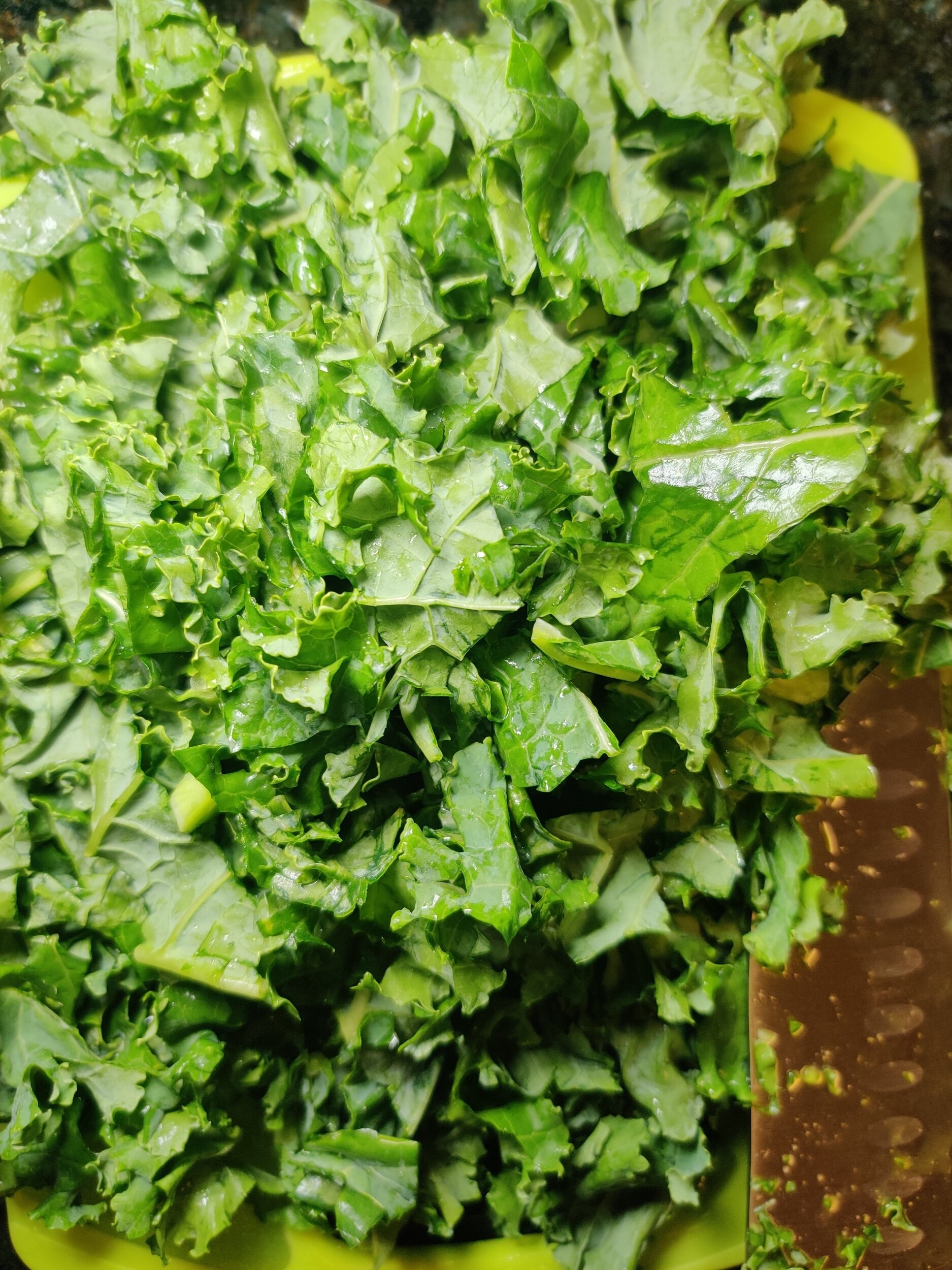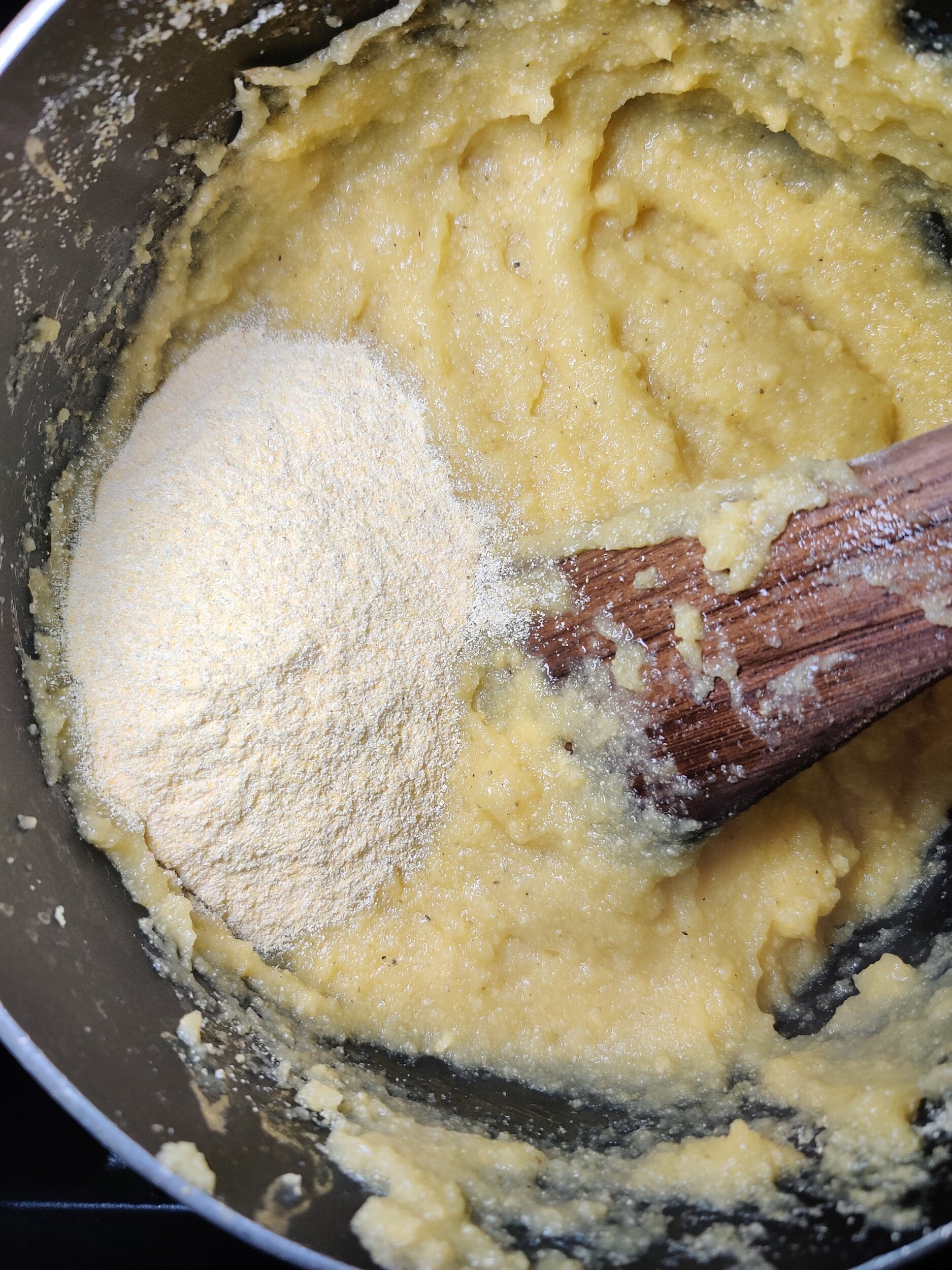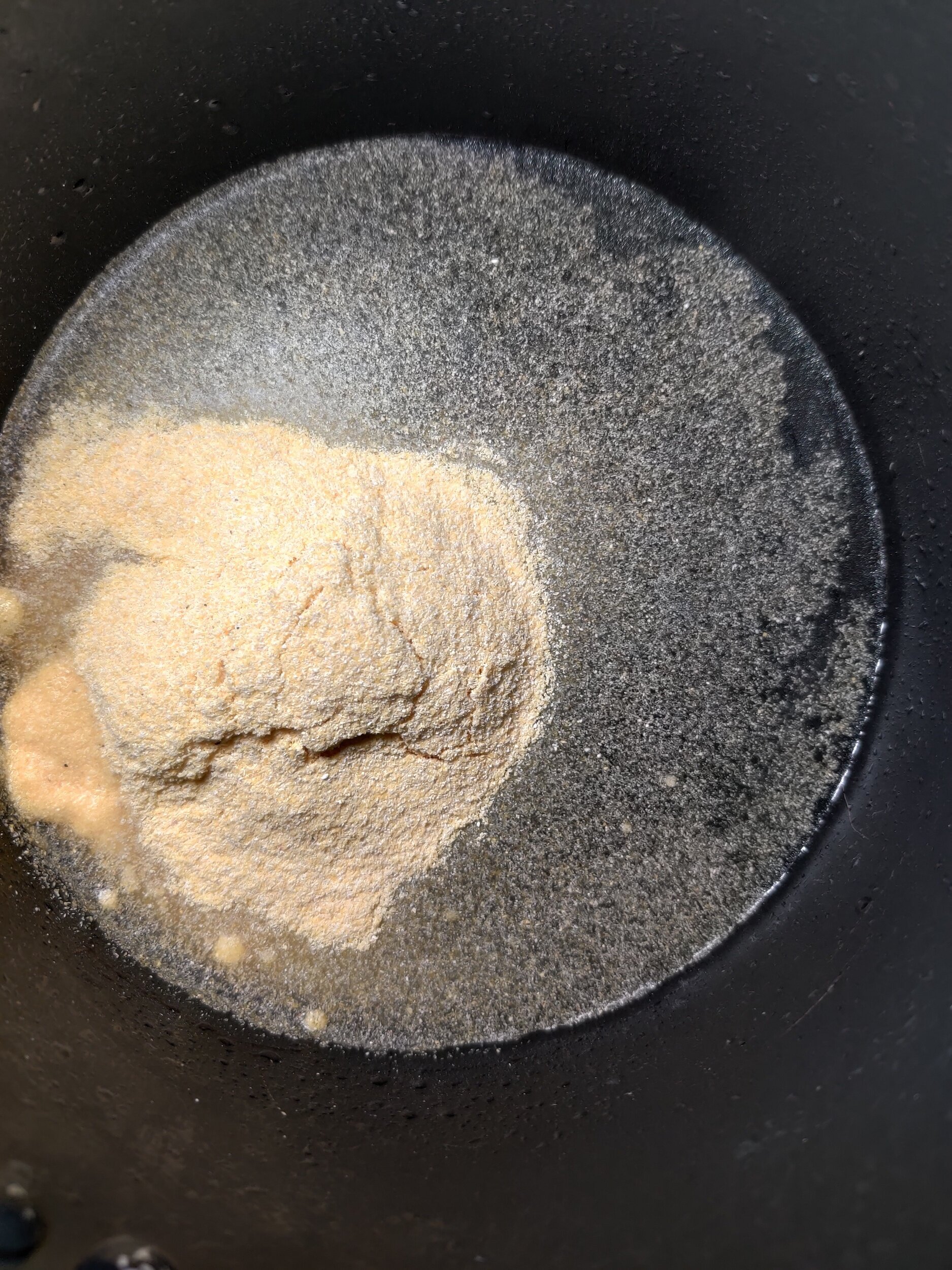Oxtail and Butternut Stew
Oxtail. A delicacy set aside for special occasions (at least for me growing up in Zimbabwe). Whenever I saw my mother preparing the bones for the pressure cooker, I would get so excited. Nothing delighted me more than watching every part, from the chopping of the green onions to the constant check-ups and stirs. I've tried oxtail in various cuisines, from Vietnamese oxtail pho to Jamaican jerk oxtail with white beans. I appreciated both, but this simple version of slow cooking the bones with tomatoes and onions many Zimbabwes tend to go for is ideal, in my opinion!
Southern African potjiekos inspired this recipe. Potjiekos are stews left untouched in cast-iron three-legged pots over hot coals, often a mixture of meat, bones and vegetables. With this method in mind and to add some substance, I used butternut.
Oxtail is something to indulge in once in a while, but it's worth it every time. Check out this recipe if you need instructions for the sadza (traditional Zimbabwean starch made of mealie/cornmeal cooked into a soft, thick porridge), although in this case I used finger millet (zviyo).
Sadza Nenyama (Beef and Kale Stew)
Zimbabwean Sadza with Kale and Beef Stew: A Hearty African Comfort Food
If you're looking to explore authentic African cuisine, Zimbabwean sadza with kale and beef stew is a must-try dish that embodies comfort, tradition, and rich flavors. Sadza, a staple in Zimbabwean households, is a smooth, thick cornmeal porridge similar to fufu or pap, often served alongside flavorful stews. This hearty meal is deeply rooted in Zimbabwean culture and represents the essence of home-cooked comfort food.
In this recipe, tender beef chunks are slow-cooked in a savory, aromatic tomato-based stew, perfectly balanced with nutrient-packed kale. That said, bone-in cuts are more common for this dish, and, in my opinion, provide a more flavorful, rich broth to tie the entire meal together. The combination of rich, meaty flavors and wholesome greens pairs beautifully with sadza, creating a satisfying meal that warms the soul. Whether you have Zimbabwean roots or are simply looking to try something new, this dish is a delicious way to experience the heart of Southern African cuisine.
If there was any meal I got sick of eating as a kid, it was this. As an adult far from home, I found myself with a new-found appreciation, and wanted to share the steps to materialize the meal. While I’ve personally cut down on meat, this classic dish still brings comfort, warmth, and a taste of home, especially on cold or rainy days.
For more recipes inspired by traditional Zimbabwean, cuisine, browse the website or check out Oxtail and Butternut Stew, Fried Sadza with Chilli Creamed Corn, Sadza with Butter Bean Kale Relish, Sadza and Creamed Spinach with Sardines, Huku ne Dovi (Zimbabwean Peanut Chicken Stew), and Black-Eyed Peas with Coconut and Tomato.

Sadza Nenyama (Beef and Kale Stew)
Ingredients
- 1 pound chuck beef or cut ideal for stew
- 1/2 large bunch kale, chopped
- 1 tablespoon butter
- 2 tablespoons vegetable oil
- 1 teaspoon salt
- 1 tablespoon black pepper
- 3 tablespoons Royco Usavi Mix (optional but highly recommended - you can also use a blend of 1 teaspoon cumin, 1 teaspoon coriander, 1/2 teaspoon turmeric, 1/4 teaspoon paprika, 1/4 teaspoon cornstarch, and 1/2 teaspoon fenugreek powder)
- 1 yellow onion, diced
- 3-4 Roma tomatoes, diced
- 1 tablespoon fresh garlic
- 1 tablespoon chili flakes
- 3 beef or vegetable bouillon cubes
- 3 cups water
- 1 1/2 - 2 cups cornmeal/mealie meal (I used yellow cornmeal)
- 1 teaspoon salt
- 3 cups boiling water
- 3/4 cup cold water
- 1 teaspoon garlic powder
Instructions
- Prepare your stew. In a large pot, add the butter and vegetable oil. Sauté the onion and garlic until the onion becomes translucent and the garlic fragrant, about 3-4 minutes. Add the salt, pepper, and spice blend, cook for another 2-3 minutes.
- Add the beef chunks and chilli flakes, brown the meat by cooking for about 5-7 minutes. Add the diced tomato and bouillon cubes, mix to incorporate.
- Add the chopped kale, followed by water (or liquid broth if you're using that). Reduce the heat and simmer for 30 minutes with the lid on top, stirring occasionally and seasoning to taste. You want your beef tender and cooked through, but not tough - so don't overcook.
- While the stew is cooking, make you sadza. Boil the water.
- In a medium-sized pot, stir 1/2 cup of the cornmeal with the cold water to make a paste (not too thick, not too thin).
- Season, then while stirring, add the boiling water - careful not to splash yourself! The heat should be on medium as your stir. After about 4-5 minutes, the cornmeal will begin to bubble. You can close the pot with the lid, and allow it to cook for about 15-20 minutes. Don't burn the bottom of your pot - you may need to reduce the heat to medium-low depending on your stove!
- Bring down the heat to low, and add the remaining cornmeal a 1/2 cup at a time, folding it in to make a soft dough - the softer you want the sadza the less cornmeal, for a thicker consistency use more . Place the lid back on the pot, leaving a slight opening, allowing the sadza to rest over the heat for about five minutes.
- Remove from heat and shape with a wooden spoon. Serve hot with the stew.
Notes
- For vegetarian alternative, use butternut or pumpkin cubes instead of beef.
- Sadza tastes better eaten hot, so try to serve immediately, storing until the next day hardens it. Consume the stew within 3-4 days when refrigerated, otherwise, freeze.
I am not a certified nutritionist and any nutritional information on dontmissmyplate.com should only be used as a general guideline.
Tried this recipe? I’d really love to know how it turned out for you. Leave a quick review or comment below — your feedback helps others (and makes my day!).
Sadza with Butter Bean Kale Relish
Ah yes, I love a meal that tastes like home. Home being Zimbabwe in this case. There's nothing like a plate of hot relish (stewed vegetables) and sadza (thick corn/maize meal porridge). This is considered one of the cornerstones of our cuisine and feeds millions of people across the country. It's kind of like how pasta is to the Italians dare I say!
Perhaps I'm biased, but it's some of the best-tasting comfort food, and not smothered in fat either. I made it vegan although some Zimbabweans would request some grilled or in-bone meat. You can do without it.
The one thing I'd insist you include if possible is the Usavi mix. It's a spice brand you'll find in most households but is essentially just a blend of cornstarch, salt, sugar, turmeric, coriander, garlic, fennel, methee/fenugreek, cumin, and paprika. Some people like to add curry powder to their relish, but I find that changes the flavour profile into something completely different. This is all about simple deliciousness!
Ingredients
1 can butter/Lima beans (keep the sauce)
1 tablespoon garlic, minced
1 tablespoon olive oil
1/2 onion, chopped
1/4 tomato, chopped
2 tablespoons Usavi mix
1/2 teaspoon salt
1 tablespoon chili flakes
1 teaspoon black pepper
1/4 cup water
1 tablespoon butter
2 tablespoons vegetable
3 cups chopped kale
Sadza:
1 cup white corn/maize meal
3/4 cup cold water
2 1/2 - 4 cups boiling water (depending on how thick you want your sadza)
1/2 teaspoonsalt
Instructions
Heat the olive oil and butter, saute the garlic and onions for about 3 minutes to sweat them out.
Add the Usavi mix, salt, and pepper, cook for another 2 minutes to bring out the flavours.
Add the chopped kale and cook until wilted down, then add the tomato and vegetable oil and fry for 2 minutes.
Add the beans along with the sauce from the can, chilli flakes, and water. Reduce heat and simmer for about 10 minutes, stirring occasionally. Set aside.
Prepare your sadza. In a pot, make a paste using the cold water and a 1/2 cup of maize meal, add the salt. When you add the cold water, do it gradually to keep control of the consistency of the paste, you don’t want clumps and it should all come together.
Place the pot over medium-high heat and add 1/2 cup of boiling water. With a wooden spoon, stir quickly and get rid of any lumps. You want a smooth porridge to form. If you need to, use a whisk!
Add the rest of the hot water a 1/2 cup at a time, still stirring or whisking to ensure you still develop a smooth porridge. At this point, it will start to bubble or kwata. Reduce to medium-low heat and place a lid on top. Careful not to get burnt. Let the sadza cook for about 10 minutes.
Once cooked, fold in the rest of the corn/maize meal. You’ll want to use a twisting or figure-8 motion with your wooden spoon to make sure all the dry mix is coated and you incorporate air. This is the final step to make it a thick, dough-like consistency. You can add more corn/maize meal depending on the texture and consistency you want.
Put the lid back on and sit on low heat to allow the sadza to rest for about 5 minutes. You might hear it 'breathing' or puffing at this point.
When ready to serve, dip your wooden spoon in some cold water to prevent too much sticking. Mould your sadza into a round shape and serve with your relish, enough for 2 people.
Tip: to smoothen your sadza use cling wrap as you shape it.
Also, eat with your (washed) hands! It tastes better.


